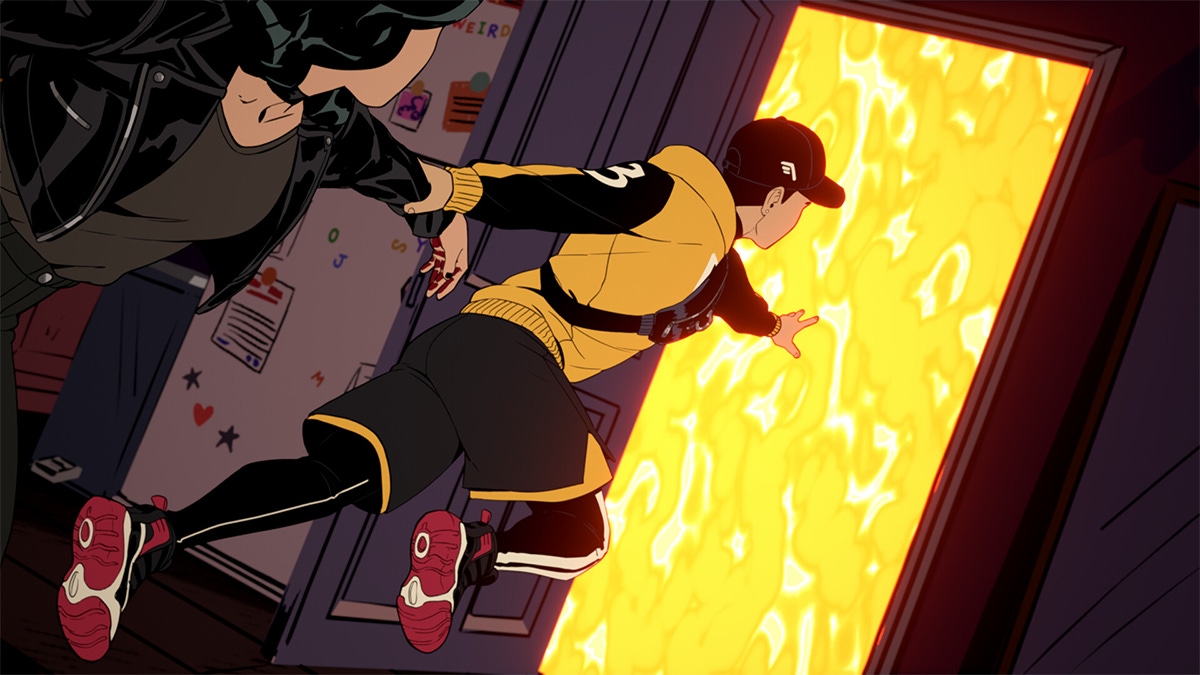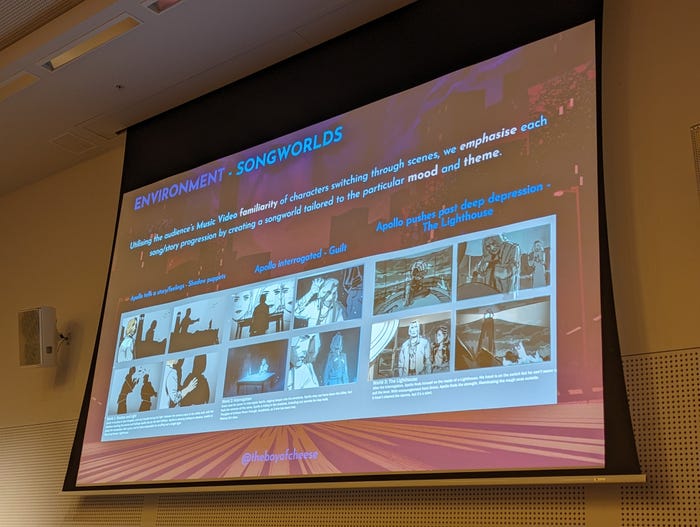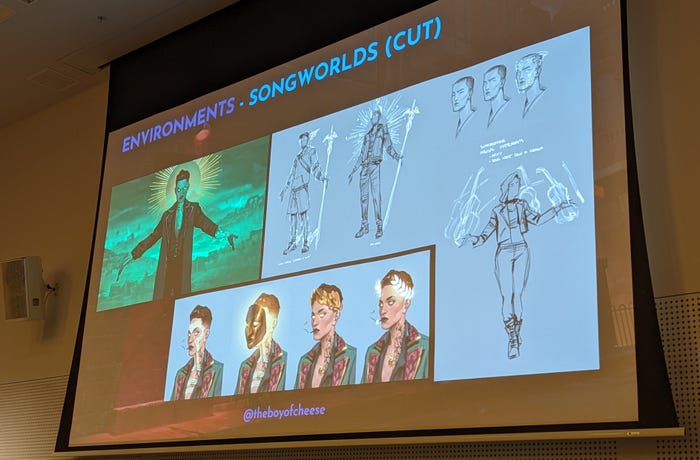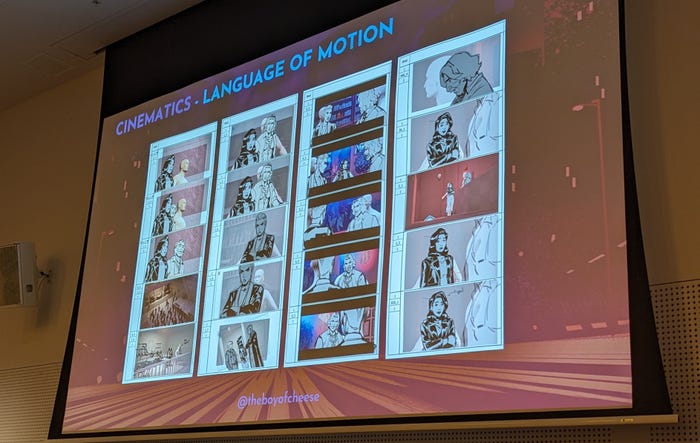Trending
Opinion: How will Project 2025 impact game developers?
The Heritage Foundation's manifesto for the possible next administration could do great harm to many, including large portions of the game development community.

Deities. Romance. Murder. Musical numbers. If you're someone who finds those words even remotely titillating, then Stray Gods is the roleplaying musical for you. Summerfall Studios' melodic adventure asks players to change their fate by harnessing the powers of musical persuasion to unravel the mystery behind the Last Muse Calliope's death.
As they untangle the tuneful tragedy, players will find themselves pulled into eclectic 'songworlds' that allow them to take center stage in a unique gameplay segment inspired by music videos. During these eclectic sequences, players must navigate a series of choices in order to finish the song and return to Stray Gods' neo-mythical reality.
Breaking down the visual design beats behind Stray Gods' "real weird" songworlds during a recent talk at Games Connect Asia Pacific (GCAP) in Melbourne, Summerfall art director Ben Ee said the studio knew it needed a way to "visually distinguish when someone was in song versus in the diegetic real world," which essentially meant figuring out how to effectively communicate someone's plight as they sing and dance through their feelings.
Early iterations of Stray Gods' songworlds were conceived while the project was still known as Chorus, and veered towards simple, abstract-colored rooms and prop-laden sets reminiscent of a Broadway stage.
After receiving some valuable advice from Jin of BTS fame (via a text message that may or may not have been legitimate), the studio decided to pivot slightly and starting analyzing K-pop videos to better understand how to create a cohesive stage. "Looking at K-pop videos was truly inspiring because they often featured rooms with visual metaphors based on what they were singing about both in lyric and mood," explained Ee, noting how those videos essentially turn entire stages into dynamic, emotionally charged dioramas.
Inspired by the likes of BTS ('Idol') and Blackpink ('Kill This Love'), the studio set about constructing sets that were "eye-catching but not complex," relying on a strong use of color and contrast to set the mood. Those K-pop videos often featured multiple worlds that artists would be inexplicably swept through, which was another aspect Summerfall sought to replicate.
"Have you ever noticed how in music videos they sometimes just swap through worlds? Like, someone will be having a little dance in the banana room and then suddenly someone is looking really grim sat in a chair surrounded by spikes and you're like 'that's normal,'" added Ee. "By utilizing the audience's cultural expectations about what music videos look like, we were able to plunge into that sort of storytelling, which was a bit of a risk but I think we pulled it off."
Curiously, Ee noted that each songworld was often conceptualized before the songs had even been finalized. "A lot of times when we were trying to figure out what songworlds looked like, we didn't have any songs to work off of," they explained. As a result, many of those early concepts were informed by Summerfall's belief that visuals should use feeling to convey a narrative message.
In the case of the god of sun and light, Apollo, utilizing that form of storytelling resulted in the studio creating three sets (or three acts) for a single song that depicted them quite literally shrouded in dark thoughts. "It's pretty bleak [...] and shows his guilt [over Calliope's murder]," said Ee.
In the second act, Stray Gods' protagonist Grace uses her power to interrogate Apollo and pull him into the light despite his desire to remain in the shadows. After being questioned, Apollo then finds himself inside a lighthouse where, with encouragement from Grace, he might find the strength to activate the great beacon and begin processing his feelings.

It's an approach that contrasts one of the earliest iterations of songworlds that Summerfall considered. Initially, the studio played with the idea of creating 'competitive' songworlds that involved gladiator arenas or boxing rings that would allow characters to attack each other using songs and lyrics, but that was ultimately rejected despite Ee liking the idea.
That wasn't the only concept that didn't make the grade. When figuring out how to visually represent the gods themselves in songworlds, a myriad of approaches were considered, including giving them glowing tattoos and other dramatic visual cues like theatrical masks. Another option was to let gods indulge in rapid-fire costume changes, which, as Ee notes, is "very classical to music videos where there are different outfit changes that often result in cries of 'slay!' or 'hell yeah!'"
It was a fun idea but one that Ee claimed would have "killed" a lot of the team in a production sense because of obvious scoping issues. In the end, Summerfall landed on giving characters glowing eyes because it was "simple and straightforward" and presumably wouldn't completely derail production.

At this stage, Summerfall had figured out how to make its songs flow but was struggling to make the Stray Gods' vibrant cast feel dynamic. The studio's decision to pursue a 2D on 3D art style meant it was easy for characters to become static, especially in songs "when there was a genuine rhythm we needed to keep up with."
Referencing some early storyboards, Ee felt it was obvious that the team needed a professional cinematic eye to "discover our language of motion." After enlisting the help of story lead and artist, Sasha Mutch, the studio moved away from "long drawn-out compositions" that were intended to feel like comic book panels but just felt way to stagnant. Instead, it began reusing sprites and drawings as much as possible while leaning on expression and pose changes to achieve a dynamic, animatic look without exceeding production budgets.
"In order to maximize sprite reuse Sasha advocated for full-body sprites to be drawn, building a library of poses and expressions that could be used across all sorts of conversations. It was a hefty ask for both production and optimization and I created some friction myself," added Ee, "but the value of having more dynamic cinematics made the risk worth it, and I think it paid off."

Ee added that Summerfall's animatic approach isn't quite full-blown animation, but presents enough variation that players' minds essentially fill in the blanks. It's fascinating to hear Ee admit they initially pushed back against the animatic pivot, but it's an anecdote that highlights a key lesson. Reflecting on the journey from concept to launch, Ee said it's critical to acknowledge that development is a team effort, and that ultimately means "being open to ideas about how things could be better."
"Listen to your team, their ideas, and their concerns," he said. "Find their strengths, uplift them and empower them, and learn when to go with the flow. Choose your battles and let go when you need to. You are not the art, your team is. Lean on their strengths."
Game Developer was invited to GCAP and Melbourne International Games Week by Creative Victoria, which covered flights and accommodation.
Read more about:
FeaturesYou May Also Like